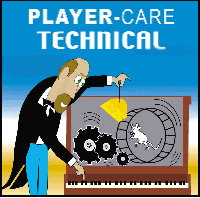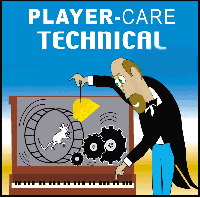
|

|

|

|

|

|
| Home | Manuals | Supplies | Search | Consult | Contact | Testing | Service |


Removing Old Lead Trackerbar Tubing from the Windchest or Stack |
|
The following videos are pretty much self-explanatory. Remember, this is pure lead, and it is considered a hazardous material. So, if in doubt about how to properly dispose of it, contact your local recycling center. Also, I do sell the brass nipples and elbows that are needed to do this job. They are called 5/32" nipples or elbows. We also now carry custom made reducing nipples which make the job much easier and neater.
|
|
I started my player piano restoration. I have the thin wall lead tubing on the tracking bar. All, except a couple look to be in good shape. The glue looks to be stable and intact on all but 1. There are 3 that have a kink in them. The inside of the tubing appears to be OK. My question is this. I think the appropriate thing to do since I am in there is to replace them all. The tubing goes all the way thru to the tracking bar. Which neoprene tubing should I use as a suitable replacement? If I use the neoprene tubing, does it go all the way through to the tracker bar too? Do I have to be concerned that it is not as rigid as the lead tubing? Is it glued in place as the lead tubing was with Hide glue? I would like to place an order on your website for this tubing and for the fabric for all the bellows. Can you tell me which fabric and how much I will need for this one and only restore?
Thanks Hi Kevin, Generally speaking, lead trackerbar tubing was not glued to the brass nipples at the trackerbar end. It was held in place with a rigid sealer. At the other end, where it goes into the stack, it was generally held in place with burnt shellac (or another type of sealer). Naturally, a sealer can sometimes be just as difficult to remove as a glue, but that's not generally the case. I have a number of YouTube videos about dealing with trackerbar tubing. My channel is: johnatuttle Also, I have a number of web pages at my site, see the 'Restoration/Repair/Care drop-down menu (Removing Lead Tubing). As for which trackerbar tubing is best for your mechanism, there are a few considerations. Mainly, 'does the tubing have to pass through any pieces of wood that have pre-cut holes?' If so, 'what's the diameter of those holes?' The second consideration is, 'does the tubing have to make any sharp bends?' Generally speaking, the regular trackerbar tubing (3B) can handle a fairly sharp bend without kinking, whereas the thin walled tubing (3A) has a tendency to collapse. Sometimes, it's necessary to install brass elbows at the point where the tubing makes a sharp bend to eliminate the possibility of 'pinching'. This is almost always the case when you have a unit with lead tubing that has an outside diameter of less than 7/32". Regarding rigidity, you do not have to be concerned that the rubber tubing is not as rigid as the lead tubing. When these units were made, lead tubing was plentiful and convenient, and rigidity never entered into the equation. The lead tubing doesn't support anything or keep anything is place. BUT, it was relatively easy to form into a neat looking array that didn't take up very much space, and this is the 'third' basic consideration when selecting the replacement tubing. In some players, there is very little room between the action of the player and the action of the piano. If the replacement tubing 'bows' outward towards the piano action, it can interfere with the piano action, and that's not acceptable. Lastly, rubber trackerbar tubing should not be glued in place. It is specifically manufactured to hold firmly to the trackerbar or to any brass nipples or elbows to which it gets connected. As for the types and amounts of cloth you will need to do all the bellows, please read the information at: https://www.player-care.com/how_much_cloth.html Hope this helps. Musically,
John A Tuttle
P.S. Portions of this email might get used in a webpage about
trackerbar tubing. If you've seen my videos about retubing a transposing trackerbar, then you only need to know the following: Cut all of the lead tubing about 2" back from the trackerbar and remove the bar from the spoolbox. Option #1, soak the trackerbar in denatured alcohol for three days -or until the sealant gets soft. Then, using a brush, brush off as much of the sealant as possible. Next, using a box cutter or other sharp knife, cut a 3/4" slit in every piece of lead tubing where it connects to the brass nipple. Pull off the lead tubing. NOTE: Soaking the bar in gasoline softens the sealant faster, usually overnight, but it could take awhile to get rid of the smell. Option #2, using knives and picks, chip away the sealant. cut the slit in the lead tubing and pull it off. Option #3 -ONLY FOR THE BRAVE! Using a heat gun, heat up the sealant and pull off the lead tubing. BEWARE, if you get it too hot, the solder that holds the brass nipple in place will melt and you'll pull off the nipple. Getting them soldered back in place is a work of art. I use gasoline and then I soak the clean bar in lacquer thinner for a day to get rid of the smell of the gas. Then I carefully polish the bar before installing it and retubing it. |
|
Since "Player-Care" is an internet business, I prefer that we correspond via E-Mail (click here to fill out the 'Request Form'). However, if I'm not in the middle of some other activity, you can reach me at 732-840-8787. But please understand that during the hours from 8AM-5PM EST (Mon-Sat), I'm generally quite busy. So, I probably won't answer the phone. If you get the answering machine, please leave a detailed message stating the reason for your call. Also, repeat your name and phone number clearly and distinctly. By necessity, I prioritize everything in my life. And, if you call and just leave your name and number, and ask me to call you back, it might be a day or two before I return your call. Why? Because I don't know why you want me to call and I might not be prepared to assist you in an effective and efficient manner. If you leave me an E-Mail address (which I prefer), spell it out phonetically. The more you do to help me, the more I can help you in return. Don't rush. You have four minutes to record your message. |
|
407 19th Ave, Brick, NJ, 08724 Phone Number 732-840-8787 (Voicemail Only, No Texts) |
